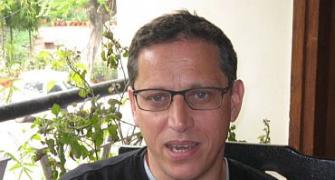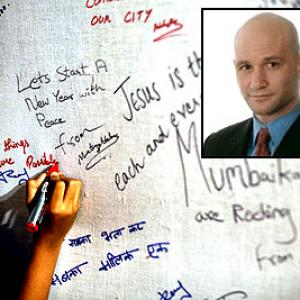Two years after the Mumbai attacks, and despite the intense global crackdown, one of the world's most networked, resourceful and dangerous terrorist groups, the Lashkar-e-Tayiba, remains operational in Pakistan, and ready to hit again.
Hundreds of university students, including foreigners, are reportedly (BBC Urdu Service, November 4, 2010) undergoing various stages of training at Lashkar's new training campus near Muzaffarabad, the capital of Pakistan occupied Kashmir.
The BBC quoted a 23-year-old engineering student from Lahore as saying that hundreds of students from Pakistan and other countries were getting training to 'wage jihad against India' in these camps. He said he completed the two-month training course -- Daura-e-Aam -- after completing his engineering course early this year.
A majority of the trainees were from Punjab where Lashkar operates from two parallel headquarters -- one at Muridke near Lahore which, till the Mumbai attacks, was the main training campus and the second one at Chouburji in Lahore where Mohammad Saeed and his confidants run a madrassa-mosque complex.
The report said the trained students were awaiting Saeed's orders to either go to Kashmir to renew their jihad against India or remain inside Pakistan to propagate Islam. Lashkar works for converting Pakistan into a radical Sunni State as part of its overall objective of establishing a Caliphate.
The training was being carried out at Dulai where Lashkar had relocated its training camps after the Mumbai attacks. Till then, the main campus was at Shawai Nala near Muzaffarabad, called Baitul Mujahideen.
Lashklar operational commander Zaki-ur Rahman Lakhwi used to run this complex. The Dulai campus is headed by Yusuf Muzamil, Lakhwi's second-in-command and one of the main accused in the Mumbai attacks.
Like Baitul Mujahideen, the Dulai camp is Lashkar's new command centre, which is connected to the world with high-speed broadband Internet and other communication facilities.
The camp is located in an area of about 39,325 square yards and was leased out by the terrorist group in March 2009 at a monthly rent of Rs 65,000.
Since the Mumbai attacks, the group has built a mosque and 14 shelters within the complex besides a middle school named Quaid-e-Azam Academy and Al Shifa free medical centre. Times Square bomber Faisal Shahzad had trained at this camp for three months in 2009.
Almost all of Lashkar's top leadership, barring Lakhwi and some others, remains free today and work openly to expand the terror network across new regions.
Of those who are said to be in prison, Lakhwi, an Al Qaeda representative in the terror group, has been active in running the new training campus at Dulai from prison.
Lakhwi, closely aligned to the ISI and Pakistan army, has access to men, communication and other logistical requirements. Before his arrest, the ISI had given him a satellite phone and a Land Rover besides access to generous funds.
Saeed is free and runs a billion dollar charity and educational empire from a mosque in the heart of Lahore. He addresses the devout every Friday, meets with political leaders on a regular basis, addresses public rallies across Pakistan and is a special guest at the iftaars thrown by the high and mighty in Pakistan, including the present ISI chief, Lieutenant General Shuja Pasha.
His clout could be gauged from the fact that he was recently (November 11) invited as a guest speaker at a seminar organised by the Lahore high court bar association where he criticised US President Barak Obama's visit to India and said it was part of a conspiracy against China and Pakistan.
Elsewhere in Pakistan, Lashkar and its parent organisation, the Jamaat-ud Dawa, have managed to hoodwink the world by calling itself Tanzeem Falah-e-Insaniyat, which incidentally operates from the same premises which was, till November 2008, occupied by Jamaat-ud Dawa's Islamic centres.
TFI was one of the 'shell' organisations floated by the terrorist group some time back to give it a cover of charity. These centres were nothing but madrassas to indoctrinate young students, recruitment and fund collection centres for jihad.
In Lahore, for instance, TFI works out of the Jamia Masjid al Qadsia, one of the biggest mosques in the city, which today houses the terrorist group's brain trust.
Saeed, his son Talha Saeed, brother-in-law Abdur Rahman Makki and son-in-law Khalid Waleed either lead the prayers or promote and defend the group's ideology and the need for jihad to free Kashmir from this mosque.
In fact, days after Saeed was detained, his son addressed the gathering, calling for launching jihad across Asia to promote the cause of Islam.
In Karachi, the group runs its operations from Jamia Darasat al-Islamia -- a sprawling complex with a mosque, madrassa and a hostel besides the TFI office. Before the Mumbai attacks, Lashkar used to operate out of an office at Salman Terrace at Hassan Square in Gulshan-e-Iqbal.
Likewise, there are several smaller offices in Karachi -- the Jamia Masjid Khalid bin-Walid on Tariq Road, Masjid Hussain-bin-Ali in Quaidabad and a mosque in Sher Shah Colony -- where the group continues to propagate jihad and other violent activities. These offices and centres are run by paid staff of the group, most of whom had shifted from Lahore after the crackdown. The average pay of each staffer is Rs 6,000 per month.
The terrorist group's publications are freely available in Lahore and Karachi, two cities that have considerable number of Lashkar cadres.
The weekly newspaper Ghazwah is on the stands under a new name, Jarrar while the vitriolic women's magazine, Tayyibat is called Al Sifat. The students' daily, Zarb-e-Taiba is available in university campuses as Akhbaar-e-Taiba and the periodical Al-Daawa is called Al Harmian.
Since the Mumbai attacks, the group has expanded its operations in Afghanistan. It has cells in five provinces of Afghanistan, but has maximum presence in Kunar and Nuristan provinces where it works with the Haqqani network against US-led NATO forces.
The Lashkar is actively engaged in recruiting new cadres for the Taliban in Afghanistan and Pakistan. The Taliban wants to recruit about 50,000 new fighters this year.
Large-scale recruitment is taking place in areas affected by the recent floods, particularly Khyber-Pakhtunwa, where Lashkar has been engaged in rescue and relief operations under the cover of Tanzeem Falah-e-Insaniyat.
The Lashkar today has more than a core cadre strength of 50,000 trained and armed men, the strength of an army division, of which 5,000 are in Karachi and the rest largely distributed across Punjab, mostly concentrated in Lahore, Multan, Jhang and Jhelum.
The group has a cadre of dedicated trainers, many of them ex-army and ISI commandos, access to the latest weapons and funds, nearly $1 million of it from the Punjab government as grants last year!
Wilson John is Senior Fellow, Observer Research Foundation, New Delhi
ALSO READ: 'Lashkar was emboldened by the success of Mumbai attacks'
'The Lashkar-e-Tayiba has gone rogue'
Taking jihad to the rest of India








